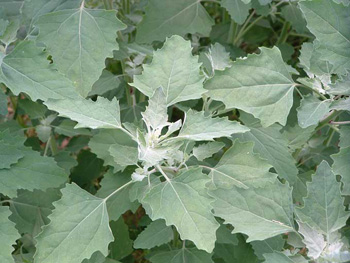Contents:
Common Names | Parts Usually Used | Plant(s) & Culture | Where Found | Medicinal Properties | Biochemical Information
Legends, Myths and Stories | Uses | Nutrient Content | Bibliography
Scientific Names

- Chenopodium album L.
- Goosefoot family
Common Names
- Hui-t’iao (Chinese name)
- Pigweed
- White goosefoot
- Wild Spinach
Parts Usually Used
Leaves
Back to Top

Description of Plant(s) and Culture
Lamb’s quarter is an erect, annual weed, 1-3 feet high; the stem often mealy, red-streaked. Leaves somewhat diamond-shaped, coarsely toothed; mealy white beneath. Flowers greenish-white, on densely flowered spikes, inconspicuous; in clusters; June to October.
Back to Top
Where Found
Found in gardens, fields, waste places. Throughout the United States.
Back to Top
Medicinal Properties
Stomachic, antiscorbutic
Back to Top
Biochemical Information
Phosphorus, iron, calcium, vitamins A, B2, Niacin, and C
Back to Top
Legends, Myths and Stories
This weed found in most gardens makes a good spinach substitute. The young tops are pinched off and steamed in a small amount of water. The nutritional value is greater than spinach, and the flavor is similar. Foliage and seeds are edible.
Although discarded by most modern Americans, not so the Native Americans. Lamb’s Quarters are a favorite among and gathered by Navajos, the Pueblo Indians of New Mexico, all the tribes of Arizona, the Diggers of California, and the Utahs. Boiled as an herb alone, or with other foods, large quantities are also eaten in the raw state.
Back to Top
Uses
Native Americans ate the leaves to treat stomachaches and prevent scurvy. Cold tea used for diarrhea. Leaf poultice used for burns and swellings. Fold remedy for vitiligo, a skin disorder.
Back to Top
Nutrient Content
Phosphorus, iron, calcium, vitamins A, B2, Niacin, and C
Back to Top
Bibliography
![]() Back to Eden
Back to Eden, by Jethro Kloss; Back to Eden Publishing Co., Loma Linda, CA 92354, Original copyright 1939, revised edition 1994
![]() Chinese Medicinal Herbs
Chinese Medicinal Herbs, compiled by Shih-Chen Li, Georgetown Press, San Francisco, California, 1973.
![]() The Herbalist Almanac
The Herbalist Almanac, by Clarence Meyer, Meyerbooks, publisher, PO Box 427, Glenwood, Illinois 60425, copyright 1988, fifth printing, 1994
![]() The Herb Book
The Herb Book, by John Lust, Bantam Books, 666 Fifth Avenue, New York, NY. copyright 1974.
![]() Eastern/Central Medicinal Plants
Eastern/Central Medicinal Plants, by Steven Foster and James A. Duke., Houghton Mifflin Company, 215 Park Avenue South, New York, NY 10000
![]() Webster’s New World Dictionary
Webster’s New World Dictionary, Third College Edition, Victoria Neufeldt, Editor in Chief, New World Dictionaries: A Division of Simon & Schuster, Inc., 15 Columbus Circle, New York, NY 10023
 The Rodale Herb Book: How to Use, Grow, and Buy Nature’s Miracle Plants (An Organic gardening and farming book)
The Rodale Herb Book: How to Use, Grow, and Buy Nature’s Miracle Plants (An Organic gardening and farming book), edited by William H. Hylton, Rodale Press, Inc. Emmaus, PA, 18049., 1974
